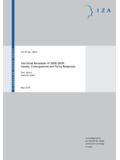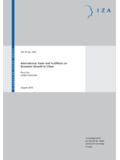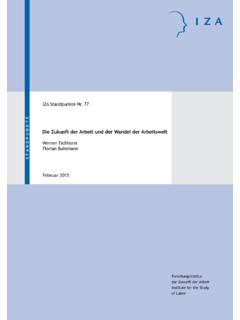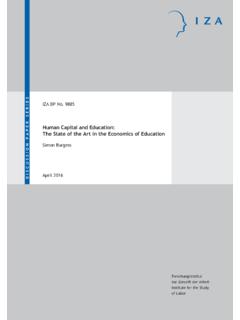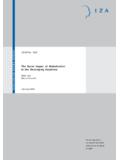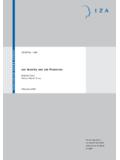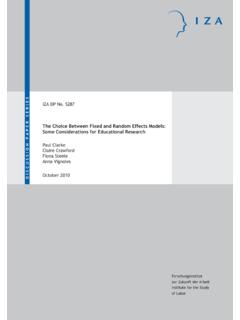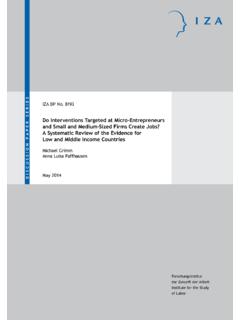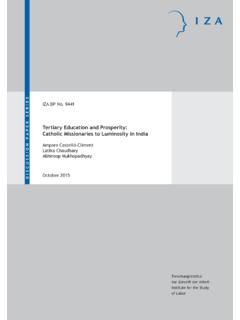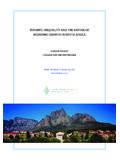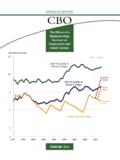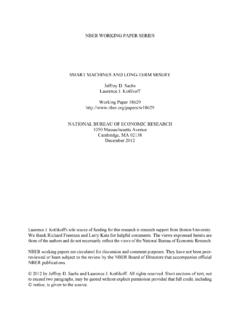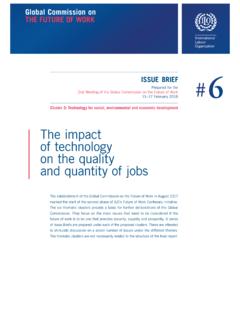Transcription of Income Inequality, Equality of Opportunity, and ...
1 DISCUSSION PAPER SERIESF orschungsinstitut zur Zukunft der ArbeitInstitute for the Study of Labor Income inequality , Equality of Opportunity, and Intergenerational MobilityIZA DP No. 7520 July 2013 Miles Corak Income inequality , Equality of Opportunity, and Intergenerational mobility Miles Corak University of Ottawa and IZA Discussion Paper No. 7520 July 2013 IZA Box 7240 53072 Bonn Germany Phone: +49-228-3894-0 Fax: +49-228-3894-180 E-mail: Any opinions expressed here are those of the author(s) and not those of IZA.
2 Research published in this series may include views on policy, but the institute itself takes no institutional policy positions. The IZA research network is committed to the IZA Guiding Principles of Research Integrity. The Institute for the Study of Labor (IZA) in Bonn is a local and virtual international research center and a place of communication between science, politics and business. IZA is an independent nonprofit organization supported by Deutsche Post Foundation. The center is associated with the University of Bonn and offers a stimulating research environment through its international network, workshops and conferences, data service, project support, research visits and doctoral program.
3 IZA engages in (i) original and internationally competitive research in all fields of labor economics, (ii) development of policy concepts, and (iii) dissemination of research results and concepts to the interested public. IZA Discussion Papers often represent preliminary work and are circulated to encourage discussion. Citation of such a paper should account for its provisional character. A revised version may be available directly from the author. IZA Discussion Paper No. 7520 July 2013 ABSTRACT Income inequality , Equality of Opportunity, and Intergenerational mobility * Families, labor markets, and public policies all structure a child s opportunities and determine the extent to which adult earnings are related to family background.
4 Cross-country comparisons and the underlying trends suggest that these drivers will most likely lower the degree of intergenerational earnings mobility for the next generation of Americans coming of age in a more polarized labor market, while the substantial rise in the Income shares of the top 1 percent, their access to sources of high-quality human capital investment for their children, and the intergenerational transmission of employers and wealth will imply a much higher rate of transmission of economic advantage at the very top.
5 JEL Classification: D31, D63, J62 Keywords: inequality , intergenerational mobility , human capital Corresponding author: Miles Corak University of Ottawa 55 Laurier Avenue East, Room 3130 Ottawa ON K1N 5N5 Canada Homepage: Twitter: @MilesCorak * Forthcoming in the Journal of Economic Perspectives. Income inequality , Equality of Opportunity, andIntergenerational MobilityThe American Dream is a very broad concept with many meanings andcertainly broader than any single statistic can measure.
6 However, when theEconomic mobility Project (2009), supported by the Pew Charitable Trust,conducted a nationally representative poll that asked Americans what they un-derstood this phrase to mean, some typical answers included: Being free tosay or do what you want ; Being free to accomplish almost anything you wantwith hard work ; and Being able to succeed regardless of the economic cir-cumstances in which you were born. These meanings have historically not onlymade the American Dream a defining metaphor of the country, they are alsolikely a reason why Americans have been willing to tolerate a good deal moreinequality of outcomes than citizens of many other rich countries.
7 B nabou andOk (2001) have called this the prospect of upward mobility hypothesis, theidea that those with lower incomes are not strong advocates of redistributivepolicies because of the belief that they, or in the least their children, are likelyto climb the Income , an emerging body of evidence suggests that more inequality ofincomes in the present is likely to make family background play a strongerrole in determining the adult outcomes of young people, with their own hardwork playing a commensurately weaker role. The OECD (2011a, p.)
8 40) hasgone so far as to state that rising Income inequality can stifle upward socialmobility, making it harder for talented and hard-working people to get therewards they deserve. Intergenerational earnings mobility is low in countrieswith high inequality such as Italy, the United Kingdom, and the United States,and much higher in the Nordic countries, where Income is distributed moreevenly. This suggestion that higher inequality skews opportunity and lowers inter-generational mobility is the starting point of this paper. In particular, my focusis on the degree to which increasing inequality in the high- Income countries,particularly in the United States, is likely to limit economic mobility for thenext generation of young paper offers a descriptive, yet structured, discussion of the underlyingdrivers of opportunity that generate the relationship between inequality and in-tergenerational mobility .
9 The goal is to explain why America differs from othercountries, how intergenerational mobility will change in an era of higher inequal-ity, and how the process is different for the top 1 percent. To lay the foundation,1I begin by presenting the evidence that countries with more inequality at onepoint in time also experience less earnings mobility across the generations, arelationship that has been called The Great Gatsby Curve. I also outline howto interpret the common statistic measuring intergenerational earnings mobil-ity and its relationship to the broader concept of Equality of opportunity.
10 Myoverview of the causal factors determining intergenerational mobility is basedupon a framework drawn from some influential economic models often usedto examine the intergenerational transmission of inequality . This frameworkfocuses attention on the investments made in the human capital of childreninfluencing their adult earnings and socio-economic interaction between families, labor markets, and public policies all struc-ture a child s opportunities and determine the extent to which adult earnings arerelated to family background but they do so in different ways across nationalcontexts.
